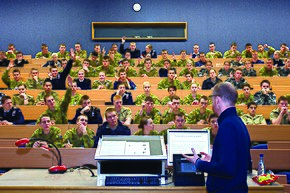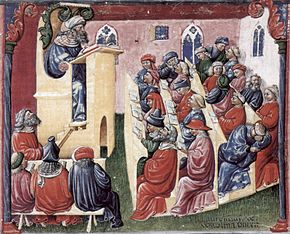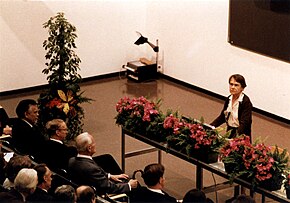299:
Nevertheless, lecturing is not the most effective method for promoting student thought, changing attitudes, or teaching behavioral skills. Bligh summarises research on memory to show the significance of the meaningfulness of material on retention (Marks and Miller 1964) and the importance of immediate rehearsal of information (Bassey 1968). He relates his own research on arousal during lectures to suggest a decrement in attention during the first 25 minutes. Lloyd (1968) and Scerbo et al. (1992) showed that students take less and less notes as lectures proceed. Bligh shows that after a short break filled by buzz group discussion, attention will recover somewhat. The largest section of Bligh's book is devoted to lecturing technique, particularly the organisation of lectures, how to make a point, the effectiveness of taking notes, the use of handouts, and ways of obtaining feedback. Early editions of the book contained a reply paid evaluation card. This research showed that the section on alternative teaching methods within lectures was the most highly praised.
216:
38:
46:
357:
27:
273:
174:
327:
Lecturing also permits the dissemination of unpublished or not readily available material. Another advantage would be for the lecturer to attract students. A vivid personality with a kind and respectful attitude in the classroom may help to recruit prospective Master and PhD students for a lecturer's own academic research.
371:
237:). Many lecturers were, and still are, accustomed to simply reading their own notes from the lectern for exactly that purpose. Nevertheless, modern lectures generally incorporate additional activities, e.g. writing on a chalk-board, exercises, class questions and discussions, or student presentations.
335:
There has been much debate as to whether or not lecturing actually improves student learning in the classroom. Commonly cited disadvantages of lecture include: placing students in a passive (rather than an active) role, encouraging one-way communication, requiring significant out-of-class time for
298:
in which teachers who know give knowledge to students who do not and are therefore supposed to have nothing worth contributing." Based on his review of numerous studies, he concludes that lecturing is as effective, but not more effective, as any other teaching method in transmitting information.
302:
The conception of the lecture as needing to be a didactic event has been challenged by
Meltzer and Manivannan (2002) and Sandry (2005) who maintain that lectures can involve active learning. However, Elliot (2005) sees difficulties in the encouragement of active learning with phenomena such as
211:
was for the instructor to read from an original source to a class of students who took notes on the lecture. The reading from original sources evolved into the reading of glosses on an original and then more generally to lecture notes. Throughout much of history, the diffusion of knowledge via
326:
The effectiveness of traditional lecture is and has been debated. Some advantages of lecturing include: quick exposure to new material, greater teacher control in the classroom, an engaging format, which may complement and clarify course material, and facilitating large-class communication.
248:
has changed the form of lectures, e.g. video, graphics, websites, or prepared exercises may be included. Most commonly, however, only outlines composed of "bullet points" are presented. Critics such as
103:, or even a business person's sales presentation may be similar in form to a lecture. Usually the lecturer will stand at the front of the room and recite information relevant to the lecture's content.
480:
during the mid-19th century. It referred to the custom of inviting noted speakers to deliver private lectures, which were typically hosted in the parlors of wealthy and socially influential families.
129:
Lectures have a significant role outside the classroom, as well. Academic and scientific awards routinely include a lecture as part of the honor, and academic conferences often center on "
229:
Even in the twentieth century, the lecture notes taken by students, or prepared by a scholar for a lecture, have sometimes achieved wide circulation (see, for example, the genesis of
110:, universities have not yet found practical alternative teaching methods for the large majority of their courses. Critics point out that lecturing is mainly a one-way method of
859:
559:
Marks L.E. and Miller G.A. The role of semantic and syntactic constraints in memorization of
English sentences. Journal of verbal learning and verbal behavior 1964 3(1)
707:
367:
While lecturing is generally accepted as an effective form of instruction, there have been some prominent educators who have succeeded without the help of lectures.
689:
41:
A lecture at the
University of Bologna in Italy in the mid-fourteenth century. The lecturer reads from a text on the lectern while students in the back sleep.
757:
311:
causing audience members to be reluctant to participate. A possible solution to the encouragement of audience involvement in lectures is the use of an
157:, and other organizations have hosted lectures in furtherance of their missions or their constituents' interests. Lectures represent a continuation of
773:
Newton, Philip (2016). "Academic integrity: a quantitative study of confidence and understanding in students at the start of their higher education".
318:
Shoufan (2020) argues that with a proper usage of learning technology, the lecture can be omitted and completely replaced by learning activities.
347:
College is a place where a professor’s lecture notes go straight to the students’ lecture notes, without passing through the brains of either.
199:" is from the 16th century. The verb "to lecture" is attested from 1590. The noun "lectern" refers to the reading desk used by lecturers.
99:. Lectures are used to convey critical information, history, background, theories, and equations. A politician's speech, a minister's
921:
892:
851:
390:, or laboratory experiment sessions as a means of further actively involving students. Often these supplemental sections are led by
256:
A modified lecture format, generally presented in 5 to 15 minute short segments, is now commonly presented as video, for example in
649:
145:, for instance, historically have hosted numerous free and public lectures on a wide variety of matters. Similarly, churches,
551:
715:
253:
contend that this style of lecture bombards the audience with unnecessary and possibly distracting or confusing graphics.
563:
683:
965:
747:
589:
548:
527:
507:
Michael Bassey
Learning methods in tertiary education. Internal paper Nottingham Regional College of Technology 1968.
375:
31:
122:. Lectures delivered by talented speakers can be highly stimulating; at the very least, lectures have survived in
1062:
312:
754:
126:
as a quick, cheap, and efficient way of introducing large numbers of students to a particular field of study.
1067:
308:
1007:
627:
986:
195:"to read." Its subsequent meaning as "oral discourse on a given subject before an audience for purposes of
1057:
257:
336:
students to engage with the material, and requiring the speaker to possess effective speaking skills.
184:
The noun "lecture" dates from 14th century, meaning "action of reading, that which is read," from the
1077:
562:
Scerbo W.M. Warm J.S. Dember W.N. and Grasha A.E. The role of time and cueing in a college lecture.
215:
161:
in contrast to textual communication in books and other media. Lectures may be considered a type of
1072:
295:
473:
391:
577:
532:
439:
230:
88:
intended to present information or teach people about a particular subject, for example by a
16:
Oral presentation intended to present information or teach people about a particular subject
1031:
817:
245:
8:
918:
884:
208:
821:
653:
833:
790:
407:
399:
49:
808:
Shoufan, Abdulhadi (2020). "Lecture-Free
Classroom: Fully Active Learning on Moodle".
339:
The criticisms of lectures are often summarized by a quote generally misattributed to
1052:
1047:
837:
794:
743:
650:"Grey Literature - GreySource, A Selection of Web-based Resources in Grey Literature"
585:
544:
523:
423:
825:
782:
146:
115:
786:
925:
761:
737:
693:
569:
443:
276:
162:
138:
119:
107:
581:
494:
489:
304:
158:
134:
65:
942:
592:
386:
courses relying on lectures supplement them with smaller discussion sections,
37:
1041:
906:
537:Über den Nutzen und Nachteil des Vorlesens. Eine Vorlesung über die Vorlesung
515:
477:
111:
829:
624:"Lecturing: Advantages and Disadvantages of the Traditional Lecture Method"
431:
411:
261:
250:
85:
45:
885:"The Professor's Lecture Notes Go Straight to the Students' Lecture Notes"
370:
519:
427:
177:
142:
114:
that does not involve significant audience participation but relies upon
53:
26:
435:
415:
383:
340:
272:
241:
89:
361:
356:
280:
219:
212:
handwritten lecture notes was an essential element of academic life.
196:
451:
447:
387:
123:
20:
623:
469:
419:
150:
130:
96:
93:
574:
The
Cognitive Style of PowerPoint: Pitching Out Corrupts Within
540:
462:
458:
403:
154:
100:
82:
173:
395:
185:
315:
which allows audience members to participate anonymously.
665:
461:, the prevalent mode of student-teacher interaction is
556:
Jane
Mackworth Vigilance and habituation. Penguin 1970
1034:(The Chronicle of Higher Education, June 20, 2008)
705:
410:. Those other forms of academic teaching include
1039:
1032:Short and sweet: Technology shrinks the lecture
775:Assessment & Evaluation in Higher Education
118:. Therefore, lecturing is often contrasted to
879:
877:
742:(5th ed.). Intellect Books. p. 316.
852:"Advantages & Disadvantages of Lecturing"
874:
137:has a long history in the sciences and in
964:Paul, Annie Murphy (September 12, 2015).
686:What we're learning from online education
106:Though lectures are much criticised as a
712:Encyclopedia of the Sciences of Learning
472:lecture" gained currency throughout the
369:
355:
271:
224:The Anatomy Lecture of Dr. Nicolaes Tulp
214:
172:
44:
36:
25:
984:
807:
618:
616:
614:
418:if conducted by a teaching assistant),
1040:
940:
772:
708:"Natural Learning in Higher Education"
735:
1005:
963:
729:
611:
294:, argues that lectures "represent a
985:Worthen, Molly (October 17, 2015).
909:is more likely the original writer.
564:Contemporary Educational Psychology
260:(MOOCs) or in programs such as the
13:
949:13th Networked Learning Conference
934:
630:from the original on 11 March 2014
14:
1089:
1025:
862:from the original on 2 April 2015
593:The Cognitive Style of PowerPoint
180:lecturing using a projected slide
895:from the original on May 2, 2013
376:Tampere University of Technology
330:
32:Australian Defence Force Academy
1009:The Lecture in College Teaching
941:Fuller, Steve (April 8, 2014).
912:
474:British Commonwealth of Nations
966:"Are College Lectures Unfair?"
844:
810:IEEE Transactions on Education
801:
766:
699:
677:
668:
642:
351:
244:presentation software such as
235:Cours de linguistique générale
1:
787:10.1080/02602938.2015.1024199
599:
321:
905:. This source suggests that
858:. South Alabama University.
604:
168:
7:
739:What's the use of lectures?
706:J. Scott Armstrong (2012).
512:What's the Use of Lectures?
483:
292:What's the Use of Lectures?
267:
258:massive open online courses
19:For the academic rank, see
10:
1094:
856:TeachingResourcesGuide.com
500:
360:Civil lecture at Budapest
202:
18:
1006:Bane, Charles L. (1930).
430:, practical application,
478:United States of America
450:-based instruction, and
313:audience response system
830:10.1109/TE.2020.2989921
309:evaluation apprehension
296:conception of education
133:", i.e., lectures. The
1063:Educational psychology
1012:. Boston: Gorham Press
951:. Edinburgh University
755:Ch.1 and Ch. 3 reprint
736:Bligh, Donald (1998).
584:, 2006, 2nd edition).
566:1992 17(4) pp 312–328.
379:
364:
349:
287:
226:
181:
69:
57:
42:
34:
578:Cheshire, Connecticut
533:Konrad Paul Liessmann
440:experiential learning
373:
359:
345:
285:Scholars at a Lecture
275:
231:Ferdinand de Saussure
218:
176:
48:
40:
29:
1068:Academic terminology
987:"Lecture Me. Really"
919:Gaskell's Compendium
246:Microsoft PowerPoint
207:The practice in the
822:2020ITEdu..63..314S
406:rather than senior
400:teaching assistants
209:medieval university
1058:Oral communication
924:2008-12-02 at the
891:. 17 August 2012.
889:Quote Investigator
760:2014-10-11 at the
692:2012-08-04 at the
380:
365:
288:
227:
182:
58:
50:Barbara McClintock
43:
35:
626:. CIRTL Network.
510:Donald A. Bligh:
392:graduate students
378:lecturing in 2007
374:Professor of the
147:community centers
131:keynote addresses
1085:
1078:Speeches by type
1021:
1019:
1017:
1002:
1000:
998:
993:. New York Times
981:
979:
977:
972:. New York Times
960:
958:
956:
928:
916:
910:
904:
902:
900:
881:
872:
871:
869:
867:
848:
842:
841:
805:
799:
798:
770:
764:
753:
733:
727:
726:
724:
723:
714:. Archived from
703:
697:
681:
675:
672:
666:
664:
662:
661:
652:. Archived from
646:
640:
639:
637:
635:
620:
139:social movements
116:passive learning
80:
77:
74:
1093:
1092:
1088:
1087:
1086:
1084:
1083:
1082:
1073:Grey literature
1038:
1037:
1028:
1015:
1013:
996:
994:
975:
973:
954:
952:
944:The Lecture 2.0
937:
935:Further reading
932:
931:
926:Wayback Machine
917:
913:
898:
896:
883:
882:
875:
865:
863:
850:
849:
845:
806:
802:
771:
767:
762:Wayback Machine
750:
734:
730:
721:
719:
704:
700:
694:Wayback Machine
684:Daphne Koller,
682:
678:
673:
669:
659:
657:
648:
647:
643:
633:
631:
622:
621:
612:
607:
602:
597:
570:Edward R. Tufte
543:: Picus, 1994)
503:
486:
444:active learning
354:
333:
324:
277:William Hogarth
270:
205:
171:
163:grey literature
120:active learning
108:teaching method
78:
75:
72:
30:Lecture at the
24:
17:
12:
11:
5:
1091:
1081:
1080:
1075:
1070:
1065:
1060:
1055:
1050:
1036:
1035:
1027:
1026:External links
1024:
1023:
1022:
1003:
982:
961:
936:
933:
930:
929:
911:
873:
843:
816:(4): 314–321.
800:
781:(3): 482–497.
765:
748:
728:
698:
676:
667:
641:
609:
608:
606:
603:
601:
598:
596:
595:
582:Graphics Press
567:
560:
557:
554:
530:
508:
504:
502:
499:
498:
497:
495:Online lecture
492:
490:Public lecture
485:
482:
402:, or teaching
353:
350:
332:
329:
323:
320:
305:social loafing
269:
266:
204:
201:
170:
167:
159:oral tradition
135:public lecture
15:
9:
6:
4:
3:
2:
1090:
1079:
1076:
1074:
1071:
1069:
1066:
1064:
1061:
1059:
1056:
1054:
1051:
1049:
1046:
1045:
1043:
1033:
1030:
1029:
1011:
1010:
1004:
992:
991:Sunday Review
988:
983:
971:
970:Sunday Review
967:
962:
950:
946:
945:
939:
938:
927:
923:
920:
915:
908:
907:Edwin Slosson
894:
890:
886:
880:
878:
861:
857:
853:
847:
839:
835:
831:
827:
823:
819:
815:
811:
804:
796:
792:
788:
784:
780:
776:
769:
763:
759:
756:
751:
749:9781871516791
745:
741:
740:
732:
718:on 2014-09-16
717:
713:
709:
702:
695:
691:
688:
687:
680:
671:
656:on 2016-06-03
655:
651:
645:
629:
625:
619:
617:
615:
610:
594:
591:
590:0-9613921-5-0
587:
583:
579:
575:
571:
568:
565:
561:
558:
555:
552:
550:
549:3-85452-324-6
546:
542:
538:
534:
531:
529:
528:0-7879-5162-5
525:
521:
517:
516:San Francisco
513:
509:
506:
505:
496:
493:
491:
488:
487:
481:
479:
475:
471:
466:
464:
460:
455:
453:
449:
445:
441:
437:
433:
432:case examples
429:
425:
421:
417:
413:
409:
405:
401:
397:
393:
389:
385:
377:
372:
368:
363:
358:
348:
344:
342:
337:
331:Disadvantages
328:
319:
316:
314:
310:
306:
300:
297:
293:
286:
282:
278:
274:
265:
263:
259:
254:
252:
247:
243:
238:
236:
232:
225:
221:
217:
213:
210:
200:
198:
194:
190:
187:
179:
175:
166:
164:
160:
156:
152:
148:
144:
140:
136:
132:
127:
125:
121:
117:
113:
112:communication
109:
104:
102:
98:
95:
91:
87:
84:
71:
67:
63:
55:
52:delivers her
51:
47:
39:
33:
28:
22:
1014:. Retrieved
1008:
995:. Retrieved
990:
974:. Retrieved
969:
953:. Retrieved
948:
943:
914:
897:. Retrieved
888:
864:. Retrieved
855:
846:
813:
809:
803:
778:
774:
768:
738:
731:
720:. Retrieved
716:the original
711:
701:
685:
679:
670:
658:. Retrieved
654:the original
644:
632:. Retrieved
573:
536:
511:
467:
456:
381:
366:
346:
338:
334:
325:
317:
301:
291:
289:
284:
262:Khan Academy
255:
251:Edward Tufte
239:
234:
228:
223:
206:
192:
188:
183:
128:
105:
86:presentation
61:
59:
696:, June 2012
674:Tufte, 2006
520:Jossey-Bass
428:observation
352:Other forms
240:The use of
197:instruction
178:Golan Levin
143:Union halls
1042:Categories
1016:October 7,
997:19 October
976:19 October
722:2014-09-16
660:2016-05-02
600:References
468:The term "
436:case study
416:recitation
412:discussion
384:university
341:Mark Twain
322:Advantages
290:Bligh, in
242:multimedia
90:university
899:April 19,
838:219501315
795:144164927
605:Citations
522:, 2000).
452:tutorials
424:workshops
388:tutorials
362:Brain Bar
281:engraving
220:Rembrandt
191:, pp. of
169:Etymology
151:libraries
1053:Teaching
1048:Lectures
955:16 April
922:Archived
893:Archived
860:Archived
758:Archived
690:Archived
634:11 March
628:Archived
484:See also
476:and the
448:computer
420:seminars
279:'s 1736
268:Research
124:academia
81:) is an
21:Lecturer
866:4 March
818:Bibcode
501:Sources
463:lessons
459:schools
408:faculty
404:fellows
203:History
155:museums
97:teacher
94:college
76:reading
70:lēctūra
62:lecture
56:lecture
836:
793:
746:
588:
547:
541:Vienna
526:
470:parlor
396:tutors
193:legere
189:lectus
101:sermon
64:(from
834:S2CID
791:S2CID
382:Many
186:Latin
66:Latin
54:Nobel
1018:2016
999:2015
978:2015
957:2022
901:2013
868:2015
744:ISBN
636:2014
586:ISBN
545:ISBN
524:ISBN
307:and
83:oral
826:doi
783:doi
518:,:
457:In
454:.
283:,
233:'s
222:'s
92:or
1044::
989:.
968:.
947:.
887:.
876:^
854:.
832:.
824:.
814:63
812:.
789:.
779:41
777:.
710:.
613:^
580::
572::
535::
465:.
446:,
438:,
426:,
422:,
398:,
394:,
343::
264:.
165:.
153:,
149:,
141:.
68::
60:A
1020:.
1001:.
980:.
959:.
903:.
870:.
840:.
828::
820::
797:.
785::
752:.
725:.
663:.
638:.
576:(
553:.
539:(
514:(
442:/
434:/
414:(
79:'
73:'
23:.
Text is available under the Creative Commons Attribution-ShareAlike License. Additional terms may apply.



